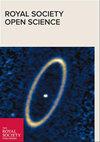Body size modulates the extent of seasonal diet switching by large mammalian herbivores in Yellowstone National Park.
IF 2.9
3区 综合性期刊
Q1 MULTIDISCIPLINARY SCIENCES
引用次数: 0
Abstract
Prevailing theories about animal foraging behaviours and the food webs they occupy offer divergent predictions about whether seasonally limited food availability promotes dietary diversification or specialization. Emphasis on how animals compete for food predominates in work on the foraging ecology of large mammalian herbivores, whereas emphasis on how the diversity of available foods generally constrains dietary opportunity predominates work on entire food webs. Reconciling predictions about what promotes dietary diversification is challenging because species' different body sizes and mobilities modulate how they seek and compete for resources-the mechanistic bases of common predictions may not pertain to all species equally. We evaluated predictions about five large-herbivore species that differ in body size and mobility in Yellowstone National Park using GPS tracking and dietary DNA. The data illuminated remarkably strong and significant correlations between body size and five key indicators of diet seasonality (R 2 = 0.71-0.80). Compared to smaller species, bison and elk showed muted diet seasonality and maintained access to more unique foods when winter conditions constrained food availability. Evidence from GPS collars revealed size-based differences in species' seasonal movements and habitat-use patterns, suggesting that better accounting for the allometry of foraging behaviours may help reconcile disparate ideas about the ecological drivers of seasonal diet switching.体型调节黄石国家公园大型哺乳类食草动物季节性食物转换的程度。
关于动物觅食行为及其占据的食物网的主流理论对季节性有限的食物供应是促进食物多样化还是专业化提供了不同的预测。大型哺乳动物食草动物的觅食生态学研究主要强调动物如何竞争食物,而整个食物网的研究则主要强调可获得食物的多样性如何限制觅食机会。由于物种的体型和活动能力不同,它们寻找和争夺资源的方式也不同--常见预测的机理基础可能并不适用于所有物种,因此协调有关促进食物多样化的预测具有挑战性。我们利用 GPS 跟踪和食物 DNA 评估了黄石国家公园中体型和移动能力不同的五个大型食草动物物种的预测。数据显示,体型与饮食季节性的五个关键指标之间存在显著的强相关性(R 2 = 0.71-0.80)。与体型较小的物种相比,野牛和麋鹿的饮食季节性较弱,当冬季条件限制食物供应时,它们仍能获得更多独特的食物。来自全球定位系统项圈的证据显示,物种的季节性运动和栖息地利用模式存在基于体型的差异,这表明更好地考虑觅食行为的异体性可能有助于调和关于季节性饮食转换的生态驱动因素的不同观点。
本文章由计算机程序翻译,如有差异,请以英文原文为准。
求助全文
约1分钟内获得全文
求助全文
来源期刊

Royal Society Open Science
Multidisciplinary-Multidisciplinary
CiteScore
6.00
自引率
0.00%
发文量
508
审稿时长
14 weeks
期刊介绍:
Royal Society Open Science is a new open journal publishing high-quality original research across the entire range of science on the basis of objective peer-review.
The journal covers the entire range of science and mathematics and will allow the Society to publish all the high-quality work it receives without the usual restrictions on scope, length or impact.
 求助内容:
求助内容: 应助结果提醒方式:
应助结果提醒方式:


